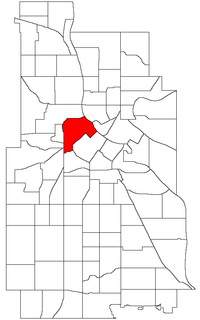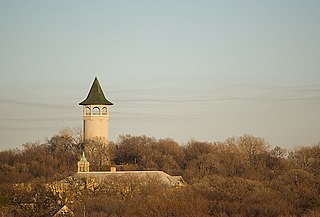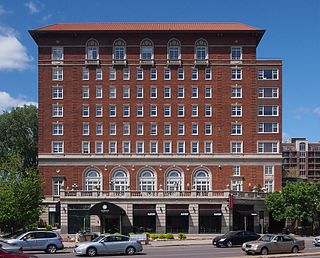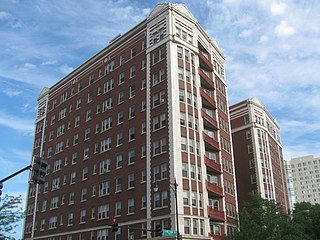
The North Loop is a neighborhood of the Central community of Minneapolis, Minnesota. The neighborhood is commonly known as the Warehouse District from the city's years as a midwestern shipping hub. It includes the Minneapolis Warehouse Historic District which is listed on the National Register of Historic Places. The North Loop is located northwest of the central business district between downtown Minneapolis and the Mississippi River. Streets in the North Loop are oriented to be parallel to the river, which means that they run at a 45-degree angle relative to the grid of the rest of the city.

Prospect Park is a historic neighborhood within the University community of the U.S. city of Minneapolis, Minnesota. The area is bounded by the Mississippi River to the south, the City of Saint Paul, Minnesota to the east, the Burlington Northern railroad yard to the north, and the Stadium Village commercial district of the University of Minnesota to the west. The neighborhood is composed of several districts which include the East River Road area. The 1913 Prospect Park Water Tower is a landmark and neighborhood icon.

Ghirardelli Square is a landmark public square with shops and restaurants and a 5-star hotel in the Marina area of San Francisco, California. A portion of the area was listed on the National Register of Historic Places in 1982 as Pioneer Woolen Mills and D. Ghirardelli Company.

Mount Vernon is a neighborhood immediately north of downtown Baltimore, Maryland. Designated a National Historic Landmark District and a city Cultural District, it is one of the city's oldest neighborhoods and originally was home to the city's wealthiest and most fashionable families. The name derives from the Mount Vernon home of George Washington; the original Washington Monument, a massive pillar commenced in 1815 to commemorate the first president of the United States, is the defining feature of the neighborhood.

The Grand Concourse is a 5.2-mile-long (8.4 km) thoroughfare in the borough of the Bronx in New York City. Grand Concourse runs through several neighborhoods, including Bedford Park, Concourse, Highbridge, Fordham, Mott Haven, Norwood and Tremont. For most of its length, the Concourse is 180 feet (55 m) wide, though portions of the Concourse are narrower.

Southwest Center City (SWCC) is a neighborhood in South Philadelphia bordering Center City, Philadelphia, Pennsylvania, United States. The neighborhood is bordered on the north by South Street, on the south by Washington Avenue, on the west by the Schuylkill River, and on the east by Broad Street. It is an area adjacent to the Fitler Square and Rittenhouse Square neighborhoods to the north and Point Breeze to the south. It is home to several community service organizations, restaurants, many churches, a few retail establishments, and some light industry.

The Beach Club Residences is an apartment community, health club, and commercial center in Minneapolis, Minnesota, United States, just across Lake Street from its namesake Lake Calhoun. Its founders intended the club to meet their residential, recreational, and entertainment needs in one building. The original building was listed on the National Register of Historic Places on December 23, 2003. It is considered significant as a rare local example of an apartment hotel, a distinctive urban housing option of American cities in the 1920s.

The Milwaukee Avenue Historic District is a historic district in the Seward neighborhood of Minneapolis. The district comprises two city blocks of small homes on quarter-sized lots. These houses were built between 1884 and 1890 by William Ragan, a Minneapolis real estate speculator. Built for lower-income residents, the houses had deteriorated in condition by the end of World War II, and by the 1970s, were planned for demolition. A group of residents and concerned citizens fought to save the houses, eventually leading to their inclusion on the National Register of Historic Places and the federal protection and rehabilitation that comes with the designation. Today, the houses sit along a bike- and pedestrian-friendly mall on which motor traffic is prohibited.

The Lowertown Historic District is a historic district in the Lowertown neighborhood of Saint Paul, Minnesota, United States. This 16-block warehouse and wholesaling district comprises 37 contributing properties built 1870s–1920. It was listed on the National Register of Historic Places in 1983 for the significance of its river and rail connections, economic impact, architecture, and urban planning. Lowertown was originally the lower landing on the Mississippi River; the first port of access to the Twin Cities. Several warehouse, railroad, banking, and distribution buildings served the entire Upper Midwest from 1880 to 1920. A significant concentration of these buildings survive, unified by similar architectural styles and construction materials. Many were designed by the city's most prestigious architects, including Cass Gilbert and Clarence H. Johnston Sr.

The Minneapolis Public Library, North Branch building is a former library in Minneapolis, Minnesota, United States. It was designed in 1893 by architect Frederick Corser. When it was opened, it was claimed to be the nation's first branch library to have open shelves so patrons could browse for books on their own, without asking librarians to retrieve them. The library set a precedent for future library development in the Minneapolis Public Library system.

Vollintine Hills Historic District is a historic district located in the Midtown area of Memphis, Tennessee, notable for its cohesive collection of 78 post-World War II Minimal Traditional and ranch-style houses built around a former synagogue. "The neighborhood represents the efforts of members of an Orthodox religious group to accommodate their beliefs by developing a synagogue and housing for the congregation within easy walking distance."

Maternity Hospital, also known as Ripley Memorial Hospital and currently known as Ripley Gardens, is a former hospital building in the Harrison neighborhood of Minneapolis, Minnesota. The hospital was established by Dr. Martha Ripley in 1886 in response to the exceptionally high mortality rates for women in childbirth. Dr. Ripley was one of only a few female physicians in the late 19th century, and she employed only women as physicians and board members. The hospital provided services for primarily poor, unmarried, and widowed women. The hospital was originally located in a house at 316 15th Street South, but it quickly outgrew that house and moved to 2529 4th Avenue South. Demand continued to grow, so in 1896 the hospital purchased a house on 5 acres (2.0 ha) of land at the corner of Glenwood and Penn Avenues. The hospital built the Marshall Stacy Nursery in 1909, followed by the Babies' Bungalow in 1910 and the Emily Paddock Cottage in 1911. Also in 1911, Ripley appealed to the government for funds to build an even larger building. Ripley died on April 18, 1912, of a respiratory infection.

The Garden Homes Historic District is a residential historic district located in the Chatham neighborhood of the South Side, Chicago, Illinois. The district includes 152 residential buildings, 88 of which are contributing buildings, built in 1919-20 as Chicago's first large housing project. The newly formed Chicago Housing Association, a group of 22 prominent Chicago businessmen that included J. Ogden Armour, Charles H. Wacker, and William Wrigley, Jr., planned the homes as an affordable housing project for working-class Chicagoans. At the time, the city was suffering from a post-World War I housing crisis, and many of its working-class residents lived in tenements or other unlivable housing. Architect Charles Sumner Frost designed the homes, which were mainly brick cottages and stucco duplexes. The houses were built on unusually large lots for the time; the extra land was designed to serve as garden space for residents.

The Admiral Apartments, originally the Wheeldon Apartments and also known as the Admiral Hotel Apartments, is a five-story brick Tudor Revival apartment building in downtown Portland, Oregon, United States, that was built in 1909. It has been on the National Register of Historic Places since 1990.

The Whitelaw Hotel is an historic structure located in the U Street Corridor in Northwest Washington, D.C. It was listed on the National Register of Historic Places in 1993.
Andrew Berman is an architectural and cultural heritage preservationist in New York City. He is known for being an advocate of affordable housing and LGBT rights. Berman was named executive director of the Greenwich Village Society for Historic Preservation (GVSHP), neighborhood preservation organization in New York City, in 2002.

The Sutherland Hotel, originally built to be the Cooper–Monatah Hotel, is a historic building in the Kenwood neighborhood of Chicago, Illinois. Built as a high-end hotel, the Sutherland was commandeered by the US government as a military hospital before it was completed. Finally opened as a hotel in 1925, the building later became famous for its Sutherland Lounge, a popular venue for Chicago's jazz scene.

The Colonial Apartments are a historic apartment building at 51-53 High Street in Bangor, Maine. Built in 1919, it is one of the oldest and best-preserved apartment houses in the city that was marketed to a middle and upper-class population. The building was listed on the National Register of Historic Places in 2012.

The East Park Towers are a historic apartment building at 5236-5252 S. Hyde Park Boulevard in the Hyde Park neighborhood of Chicago, Illinois. The building was constructed in 1922-23 during a period of residential growth in Hyde Park. While it had no guest rooms, the apartments offered similar amenities to an apartment hotel, such as housekeeping service. Apartment hotels were popular as part-time housing for wealthy workers, as they combined the amenities of in-home service with the affordability of apartments, and the East Park Towers were one of several such apartments built in Hyde Park at the time. Architect William P. Doerr designed the building in the Georgian Revival style; his design included terra cotta belt courses and quoins and Palladian windows on the first floor.

The Strand Hotel is a historic apartment hotel at 6315-6323 S. Cottage Grove Avenue in the Woodlawn neighborhood of Chicago, Illinois. Opened in 1915, the hotel offered both traditional guest rooms and long-term residences for customers who sought luxury amenities in apartment-style housing. Architects Davis & Davis designed the Classical Revival building, which has a red brick exterior with a terra cotta clad first floor, piers outlined in terra cotta, and an entablature and cornice at its roof. The hotel included a restaurant and banquet hall, the latter of which was used as a live music venue for many years. Once part of a major commercial district in Woodlawn, the hotel is now one of its few remnants and the only surviving apartment hotel building in the neighborhood.























